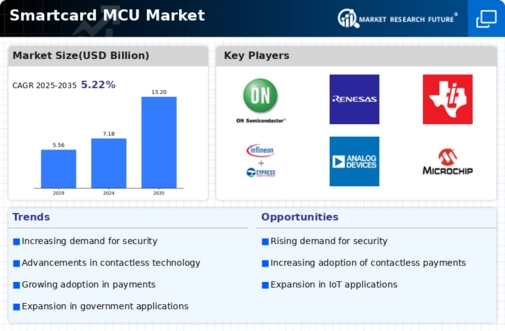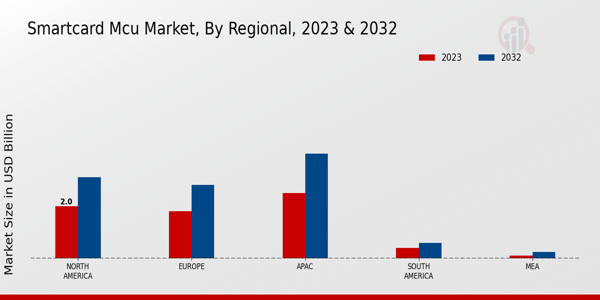Market Growth Projections
The Global Smartcard MCU Market Industry is poised for substantial growth, with projections indicating a market size of 7.18 USD Billion in 2024 and an anticipated increase to 13.2 USD Billion by 2035. This growth trajectory reflects a compound annual growth rate of 5.68% from 2025 to 2035, driven by various factors including technological advancements, increasing security concerns, and the rising adoption of smartcard solutions across multiple sectors. As industries continue to embrace digital transformation, the demand for smartcard MCUs is likely to expand, positioning the market for a robust future.
Growth in IoT Applications
The proliferation of Internet of Things (IoT) applications is driving innovation within the Global Smartcard MCU Market Industry. Smartcards equipped with MCUs are increasingly utilized in IoT devices for secure data transmission and authentication. As industries embrace IoT solutions for enhanced operational efficiency, the demand for secure smartcard technology rises. This trend is particularly relevant in sectors such as logistics and supply chain management, where smartcards facilitate secure tracking and monitoring. The anticipated compound annual growth rate of 5.68% from 2025 to 2035 underscores the potential for smartcard MCUs to play a pivotal role in the evolving IoT landscape.
Increased Focus on Cybersecurity
The heightened focus on cybersecurity measures is propelling the Global Smartcard MCU Market Industry forward. As cyber threats become more sophisticated, organizations are prioritizing secure authentication methods to protect sensitive data. Smartcards with embedded MCUs offer robust security features, including encryption and secure key storage, making them a preferred choice for various applications. Financial institutions, in particular, are adopting smartcard technology to safeguard transactions and customer information. This trend indicates a growing recognition of the importance of secure smartcard solutions, further driving market growth and innovation.
Emergence of Biometric Authentication
The emergence of biometric authentication technologies is reshaping the Global Smartcard MCU Market Industry. Biometric features, such as fingerprint and facial recognition, are increasingly integrated into smartcards, enhancing security and user convenience. This integration allows for seamless authentication processes, making smartcards more appealing to consumers and businesses alike. As organizations seek to bolster security protocols, the adoption of biometric-enabled smartcards is expected to rise. This trend aligns with the overall growth trajectory of the market, as it adapts to evolving security needs and consumer preferences.
Rising Demand for Contactless Payments
The Global Smartcard MCU Market Industry experiences a notable surge in demand for contactless payment solutions. As consumers increasingly prefer the convenience of tap-and-go transactions, smartcards equipped with MCUs are becoming essential. This trend is particularly evident in regions with high smartphone penetration, where mobile wallets and digital payment platforms are gaining traction. In 2024, the market is projected to reach 7.18 USD Billion, reflecting the growing reliance on secure and efficient payment methods. The integration of smartcard MCUs into various payment systems enhances security and user experience, thereby driving market growth.
Government Initiatives for Digital Identity
Government initiatives aimed at enhancing digital identity verification are significantly influencing the Global Smartcard MCU Market Industry. Many countries are adopting smartcard-based identification systems to streamline public services and improve security. For instance, national ID programs are increasingly utilizing smartcards with embedded MCUs to ensure secure access to government services. This trend is expected to contribute to the market's expansion, with projections indicating a growth to 13.2 USD Billion by 2035. Such initiatives not only bolster security but also promote the adoption of smartcard technology across various sectors, including healthcare and finance.















